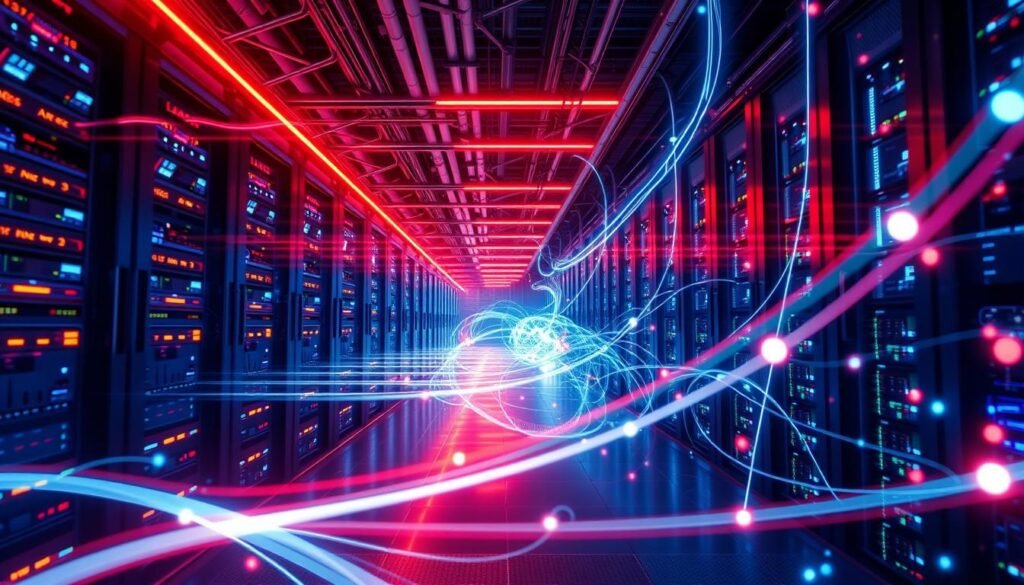When thinking about investing in AI networking, a key fact catches your eye. Broadcom’s stock value soared in 2024, hitting $51.6 billion. This is a 44% jump from the year before. The company’s software sales jumped 181% to $21.5 billion, and AI revenue hit $12.2 billion, up 220%.
This growth is a big deal for the market. It shows that companies like Broadcom are serious competitors to Nvidia. They offer new solutions for AI networking, which is in high demand.
Exploring AI networking, you’ll see Broadcom leading the way. Their semiconductor business grew 7% to $30.1 billion in 2024. This shows how much people want better network infrastructure. It’s important to know who’s playing in this field, including Nvidia’s rivals.
Key Takeaways
- Broadcom’s stock valuation more than doubled in 2024, driven by its infrastructure software sales and AI-related revenue.
- The company’s sales totaled $51.6 billion, a 44% year-over-year increase, with AI-related revenue reaching $12.2 billion, a 220% year-over-year growth.
- Advanced network infrastructure is becoming increasingly important, with companies like Broadcom emerging as strong competitors to Nvidia.
- Nvidia competitors in ai, such as Broadcom, are providing new solutions for AI networking.
- The market is expected to keep growing, with some slowdown in AI spending in 2025.
- Knowing the key players in AI networking is key for smart investments.
Understanding the AI Networking Revolution
Exploring ai data centers reveals a big change from training to using AI. This change means we need better chips and networks. It’s leading to new ways to handle and send data.
Networking tech is getting better fast, making data transfer quicker and more efficient. Leaders like NVIDIA, AMD, and Intel are pushing these boundaries. They’re making tools for ai data centers to grow.
Some big names are using ai networking to boost their work. For example, Taiwan’s Chang Gung Memorial Hospital and Foxconn use NVIDIA’s Blackwell for various tasks. This trend will keep growing, with more companies investing in ai and networking.
| Company | Technology | Application |
|---|---|---|
| NVIDIA | Blackwell platform | Medical research, imaging, language applications |
| AMD | GPU host processor module designs | AI systems, data centers |
| Intel | CPU host processor module designs | AI systems, data centers |
In conclusion, the AI networking revolution is changing how we handle data. It’s driven by improvements in ai data centers, networking, and ai solutions. Keeping up with these changes is key as the field evolves.
The Evolution of AI Networking Technologies
When thinking about the future of network technology, it’s key to see how AI fits in. AI has quickly become a big part of networking, leading to big changes. For example, high-speed networking 2025 makes data transfer and processing much faster.
AI brings many benefits to telecommunications, like better network management and more efficiency. AI can spot network problems early, cutting down on downtime and boosting performance. It also helps use network resources better, saving costs and making customers happier.
Some important stats show how AI in networks is growing:
- The global AI in Networks market is expected to reach USD 10.9 billion in 2024 and is projected to grow to USD 46.8 billion by 2029.
- Machine learning technology is expected to hold the highest market share in the AI in networks market during the forecast period.
- North America is anticipated to have the highest market share in the AI in networks market.
In summary, AI is changing the future of network technology. As high-speed networking 2025 spreads, AI’s role in telecommunications will grow. This will lead to faster, more efficient, and reliable networks.
| Market Segment | 2024 | 2029 |
|---|---|---|
| AI in Networks | USD 10.9 billion | USD 46.8 billion |
| Machine Learning | USD 3.5 billion | USD 18.2 billion |
Major Players Beyond Nvidia in the AI Hardware Space
When you look into the AI hardware world, you’ll see many companies vying with Nvidia. These ai networking companies are creating new ai networking software and technologies. They aim to meet the rising need for AI solutions.
Big names like Broadcom are making big moves in AI hardware. They could benefit from the growing need for special chips and network setups. This puts them in a good spot to challenge Nvidia’s lead. For example, Broadcom might get AI ASIC programs from OpenAI, making it a big player.
Some notable examples of ai networking companies and their offerings include:
- Broadcom: Secured the 1st and 2nd generation AI ASIC programs from OpenAI
- Qualcomm: Cloud AI 100 chip outperformed Nvidia H100 in tests
- Tenstorrent: n300 GPU nearly doubles every spec of the n150
These companies are pushing the boundaries in AI hardware. Their innovative technologies will be key in shaping AI networking’s future.
Advanced Network Infrastructure Requirements for AI Systems
When looking at the top nvidia rivals in ai, it’s key to know what AI systems need. The AI field is moving from training to using AI, which means more specialized chips and better networks. New network technologies are essential for AI networks to work well.
The AI infrastructure market is growing fast. Big tech companies like Amazon, Microsoft, and Google lead this market. They invest heavily in cloud computing and offer many cloud services, which boosts their income.
The term “AI” is a big draw for investors and startups. It brings in a lot of money and encourages partnerships with big tech firms.
Some major players in the AI infrastructure market are:
- Nvidia Corporation
- Intel Corporation
- Oracle Corporation
These companies are working hard to stay ahead. The AI infrastructure market is expected to hit $128.25 billion by 2027, growing at 30.8% each year.

The AI infrastructure market is growing thanks to new tech. As you look at the top nvidia rivals in ai, think about the latest network tech. It’s designed to meet AI’s advanced needs.
| Company | Market Share |
|---|---|
| AWS | 32% |
| Microsoft Azure | 22% |
| Google Cloud | 11% |
Implementing AI-Driven Networking Solutions
When you think about using ai technology companies’ solutions, check your network first. Look at your current setup to see if it can handle ai. Find out if there are any weak spots.
Getting your network ready for ai is key. Make sure it can handle more traffic and data. You might need to update your gear or software.
Key Considerations for Deployment
Think about these things when you set up ai networking solutions:
- Scalability: Can your network handle more traffic and data?
- Security: How will you keep your ai solutions safe from threats?
- Management: What tools will you use to keep an eye on your ai solutions?
Plan carefully to make sure your ai setup works well. This way, you can enjoy the benefits of ai. You’ll see better network performance and efficiency.
Edge Computing and AI Network Integration
Exploring edge computing and AI networks reveals the key role of machine learning networking. It makes AI systems work better and faster. The mix of AI and networking has led to better networking solutions. ai hardware competitors are key players in this area.
The edge computing market is growing fast. This is because more data is being processed at the edge of networks or devices. The global edge AI market size is expected to grow from USD 27.01 billion in 2024 to USD 269.82 billion by 2032. This is a CAGR of 33.3% during the forecast period. Big names like ADLINK Technology Inc., Synaptics Incorporated, Intel Corporation, and IBM Corporation are leading the edge AI market.
Edge computing and AI network integration have many uses. For example:
- Autonomous vehicles and robotics
- Healthcare and medical research
- Industrial automation and manufacturing
These areas use neural network algorithms to process data quickly. This helps make decisions faster and improves performance.
This technology could change many industries, from healthcare to manufacturing. Remember, machine learning networking and ai hardware competitors are vital for this integration.
| Industry | Application | Benefits |
|---|---|---|
| Healthcare | Medical research and diagnosis | Improved accuracy and faster decision-making |
| Manufacturing | Predictive maintenance and quality control | Increased efficiency and reduced downtime |
| Automotive | Autonomous vehicles and driver assistance systems | Enhanced safety and improved performance |
Security Considerations in AI Networking
When you start using AI networking, think about the security risks. Deep learning systems and cloud-based AI platforms can have vulnerabilities. Cyber attacks are getting smarter, targeting AI with backdoors, data theft, and denial of service.
To keep your AI safe, you need strong security steps. Use secure data transfer, encrypt important data, and control who can access it. Cloud-based AI platforms often have security tools like firewalls and intrusion detection.
Some important security points for AI networking are:
- Protecting against AI-specific threats such as model inversion and theft
- Ensuring the integrity and confidentiality of AI models and data
- Implementing secure deployment options for AI training, inference, and federated learning
Putting security first in AI networking helps protect your business from cyber threats. It keeps your AI systems safe. Use edge computing to lower data breach risks and confidential computing to guard sensitive data.
| Security Measure | Description |
|---|---|
| Secure Protocols | Using secure protocols for data transmission to prevent interception and eavesdropping |
| Encryption | Encrypting sensitive data to prevent unauthorized access |
| Access Controls | Implementing access controls to prevent unauthorized access to AI systems and data |
Performance Optimization Techniques
Exploring AI networking means looking into ways to make your systems better. Cybersecurity in AI networking is key to keep your data safe. Companies like IBM and Nvidia have tools to boost performance, including AI networking software to make things run smoother.
Some top ways to boost AI networking performance include:
- Building scalable systems to handle big data
- Using top-notch computing like IBM Power and Nvidia
- Improving how data moves and is stored to cut down on delays
Using these methods can make your AI systems work better and more reliably. This leads to better results and more efficient work. 
| Company | Solution | Benefits |
|---|---|---|
| IBM | IBM Power systems | High-performance computing, scalability, and reliability |
| Nvidia | Nvidia GPUs | Accelerated parallel processing, faster deep learning training, and improved real-time application performance |
By working with AI networking companies and using these techniques, you can get the most out of your AI systems. This leads to business success.
Cost Management Strategies for AI Network Infrastructure
When you think about AI network infrastructure, cost management is key. The best AI networking technologies might be pricey but they bring big benefits. Companies like Google and Intel are also diving into new network tech.
First, you’ll need to think about the cost of buying and setting up AI network infrastructure. This includes hardware, software, and professional services. Keeping costs down over time is also important. ROI optimization helps make sure your AI investment is worth it.
Some effective cost management strategies include:
- Checking your current setup and finding ways to improve
- Using cloud-based AI infrastructure to save money
- Optimizing your AI network for better performance and efficiency
By using these strategies, you can make your AI network both effective and affordable. New network tech from Nvidia rivals can help you meet your business goals.
| Cost Management Strategy | Benefits |
|---|---|
| Initial Investment Considerations | Reduced upfront costs |
| Operational Cost Control | Lower ongoing costs |
| ROI Optimization | Improved return on investment |
Future Trends in AI Networking
Exploring the future of artificial intelligence networks reveals exciting changes. The AI processor and accelerator market is expected to reach $138 billion by 2028. This growth is at a rate of 29.7% from 2024.
The importance of artificial intelligence networks will grow. Data centers are moving from 400G to 800G speeds next year. This leap is thanks to innovations like RDMA over Converged Ethernet (RoCE) and the shift from Infiniband to Ethernet.
Key trends in ai networking solutions include:
- Liquid cooling to manage thermal challenges arising from power consumption
- Data locality to reduce latency and keep GPUs busy
- Increased investment in AI infrastructure by cloud providers like AWS, Microsoft, and Google
As ai technology companies innovate, we’ll see big leaps in artificial intelligence networks. The industry’s market value is expected to add around $3 trillion this year. It’s clear AI is a big deal in tech.
| Company | Market Share | Growth Rate |
|---|---|---|
| NVIDIA | 92% | 29.7% CAGR |
| AMD | 5% | 20% CAGR |
| ARM | 3% | 15% CAGR |
Looking ahead, staying current with AI networking trends is key. Keep an eye on the latest in artificial intelligence networks, ai technology companies, and ai networking solutions.
Conclusion: Navigating the Future of AI-Powered Networking
The AI networking revolution is changing fast. It’s clear that network infrastructure will soon rely heavily on machine learning and AI hardware. Companies like NVIDIA are at the forefront. They use advanced Tensor Core GPUs and partnerships to make AI work smoothly in networks.
Network infrastructure for AI and machine learning networking will be key. They will help meet the need for more computing power. This is important for edge computing, RAN optimization, and network slicing. At the same time, AI hardware competitors keep pushing the limits with new solutions. This makes the market both dynamic and competitive.
As you move through this changing world, staying updated is vital. Working with industry leaders and embracing AI networking’s benefits is essential. By using the latest in AI hardware, software, and networking, you can achieve better efficiency, performance, and customer experiences. You can also keep your network secure and reliable.



